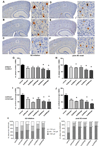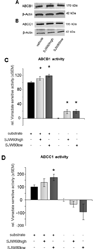Reduced Alzheimer's disease pathology by St. John's Wort treatment is independent of hyperforin and facilitated by ABCC1 and microglia activation in mice
- PMID: 24156265
- PMCID: PMC3909922
- DOI: 10.2174/15672050113106660171
Reduced Alzheimer's disease pathology by St. John's Wort treatment is independent of hyperforin and facilitated by ABCC1 and microglia activation in mice
Abstract
Soluble β-amyloid peptides (Aβ) and small Aβ oligomers represent the most toxic peptide moieties recognized in brains affected by Alzheimer's disease (AD). Here we provide the first evidence that specific St. John's wort (SJW) extracts both attenuate Aβ-induced histopathology and alleviate memory impairments in APP-transgenic mice. Importantly, these effects are attained independently of hyperforin. Specifically, two extracts characterized by low hyperforin content (i) significantly decrease intracerebral Aβ42 levels, (ii) decrease the number and size of amyloid plaques, (iii) rescue neocortical neurons, (iv) restore cognition to normal levels, and (iv) activate microglia in vitro and in vivo. Mechanistically, we reveal that the reduction of soluble Aβ42 species is the consequence of a highly increased export activity in the bloodbrain barrier ABCC1transporter, which was found to play a fundamental role in Aβ excretion into the bloodstream. These data (i) support the significant beneficial potential of SJW extracts on AD proteopathy, and (ii) demonstrate for the first time that hyperforin concentration does not necessarily correlate with their therapeutic effects. Hence, by activating ABC transporters, specific extracts of SJW may be used to treat AD and other diseases involving peptide accumulation and cognition impairment. We propose that the anti-depressant and anti-dementia effects of these hyperforin-reduced phytoextracts could be combined for treatment of the elderly, with a concomitant reduction in deleterious hyperforin-related side effects.
Figures






Similar articles
-
Hyperforin prevents beta-amyloid neurotoxicity and spatial memory impairments by disaggregation of Alzheimer's amyloid-beta-deposits.Mol Psychiatry. 2006 Nov;11(11):1032-48. doi: 10.1038/sj.mp.4001866. Epub 2006 Jul 25. Mol Psychiatry. 2006. PMID: 16880827
-
St. John's Wort reduces beta-amyloid accumulation in a double transgenic Alzheimer's disease mouse model-role of P-glycoprotein.Brain Pathol. 2014 Jan;24(1):18-24. doi: 10.1111/bpa.12069. Epub 2013 Jun 28. Brain Pathol. 2014. PMID: 23701205 Free PMC article.
-
Neurobiological effects of Hyperforin and its potential in Alzheimer's disease therapy.Curr Med Chem. 2010;17(5):391-406. doi: 10.2174/092986710790226156. Curr Med Chem. 2010. PMID: 20015041 Review.
-
The hyperforin derivative IDN5706 occludes spatial memory impairments and neuropathological changes in a double transgenic Alzheimer's mouse model.Curr Alzheimer Res. 2010 Mar;7(2):126-33. doi: 10.2174/156720510790691218. Curr Alzheimer Res. 2010. PMID: 19939230
-
Understanding drug interactions with St John's wort (Hypericum perforatum L.): impact of hyperforin content.J Pharm Pharmacol. 2019 Jan;71(1):129-138. doi: 10.1111/jphp.12858. Epub 2018 Feb 7. J Pharm Pharmacol. 2019. PMID: 29411879 Review.
Cited by
-
Apolar Extracts of St. John's Wort Alleviate the Effects of β-Amyloid Toxicity in Early Alzheimer's Disease.Int J Mol Sci. 2024 Jan 21;25(2):1301. doi: 10.3390/ijms25021301. Int J Mol Sci. 2024. PMID: 38279301 Free PMC article.
-
Unprecedented polycyclic polyprenylated acylphloroglucinols with anti-Alzheimer's activity from St. John's wort.Chem Sci. 2021 Jul 26;12(34):11438-11446. doi: 10.1039/d1sc03356e. eCollection 2021 Sep 1. Chem Sci. 2021. PMID: 34567498 Free PMC article.
-
Enhancing of cerebral Abeta clearance by modulation of ABC transporter expression: a review of experimental approaches.Front Aging Neurosci. 2024 May 30;16:1368200. doi: 10.3389/fnagi.2024.1368200. eCollection 2024. Front Aging Neurosci. 2024. PMID: 38872626 Free PMC article. Review.
-
Measurement of cerebral ABCC1 transport activity in wild-type and APP/PS1-21 mice with positron emission tomography.J Cereb Blood Flow Metab. 2020 May;40(5):954-965. doi: 10.1177/0271678X19854541. Epub 2019 Jun 13. J Cereb Blood Flow Metab. 2020. PMID: 31195936 Free PMC article.
-
Unified theory of Alzheimer's disease (UTAD): implications for prevention and curative therapy.J Mol Psychiatry. 2016 Jul 15;4:3. doi: 10.1186/s40303-016-0018-8. eCollection 2016. J Mol Psychiatry. 2016. PMID: 27429752 Free PMC article. Review.
References
-
- Alloul K, Sauriol L, Kennedy W, Laurier C, Tessier G, Novosel S, et al. Alzheimer's disease: a review of the disease, its epidemiology and economic impact. Arch Gerontol Geriatr. 1998;27(3):189–221. - PubMed
-
- Suh YH, Checler F. Amyloid precursor protein, presenilins, and alpha-synuclein: molecular pathogenesis and pharmacological applications in Alzheimer's disease. Pharmacol Rev. 2002;54(3):469–525. - PubMed
-
- Jarrett JT, Berger EP, Lansbury PT., Jr The carboxy terminus of the beta amyloid protein is critical for the seeding of amyloid formation: implications for the pathogenesis of Alzheimer's disease. Biochemistry. 1993;32(18):4693–4697. - PubMed
MeSH terms
Substances
Grants and funding
LinkOut - more resources
Full Text Sources
Other Literature Sources
Medical

